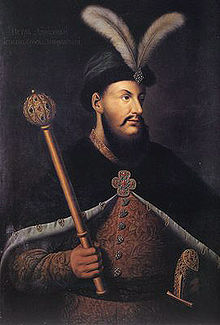Left-Bank Uprising
| Left Bank Uprising | |||||||
|---|---|---|---|---|---|---|---|
| Part of The Ruin | |||||||
| |||||||
| Belligerents | |||||||
|
|
| ||||||
| Commanders and leaders | |||||||
|
|
| ||||||
Left Bank Uprising or Bryukhovetsky Uprising was an uprising of Cossacks dissatisfied with the Andrusov truce against the tsarist government. A series of military failures of the Crimean-Cossack army led to the entry of the left-bank Ukraine into the Russian Tsardom, on the rights of autonomy
Background
[edit]A number of external and internal reasons led to the uprising. In 1665, Hetman Ivan Bryukhovetsky signed an agreement with Moscow, according to which the number of tsarist troops on the territory of Ukraine was increased, and also the local population had to pay taxes to the Russian treasury. The Andrusovo truce caused discontent, concluded between Russia and the Polish-Lithuanian Commonwealth, which cemented the split of Ukraine along the Dnieper.
Uprising
[edit]
In early January 1668, Bryukhovetsky with general officers and colonels of various ranks, decided to free themselves from the tsarist power by swearing allegiance to the Turkish Sultan. They soon rebelled, killed or handed over Russian civil servants to the Tatars as prisoners, marking the beginning of the struggle.[1]
In January, Samoilovich's Cossacks besieged Chernigov, where there was a small garrison. As a result of the assaults, the Cossacks were able to take part of the city, but not the citadel. In mid-September, Grigory Romodanovsky's field army defeated Samoilovich and unblocked the garrison.[2] As soon as news of the rebellion reached Tsar Alexei, he sent an army under the command of Romadanovsky to Ukraine. Most of the Zaporozhian Cossacks were then in Kotelve. Romodanovsky laid siege to this settlement and took the city, having received many captives. Evidence suggests that Ivan Sirko could’ve been among instigators of the uprising, planning it during late 1667.[3] Sirko launched a number of revolts during his campaign in Sloboda and Dnieper Ukraine, where he inflicted heavy defeats on Tsarist forces. However, Sirko didn’t align with the Crimean Khanate despite his opposition to Tsar.
Petro Sukhovy rose to power in the Right-Bank, supported by Krim-Giray, getting into conflict with Petro Doroshenko, who was supported by Ivan Sirko. Sukhovy and Doroshenko ultimately clashed at Chyhyryn from December 1668 to January 1669, ending with Doroshenko's victory after his ally Sirko defeated Sukhovy and his Tatar allies at the town of Olkhovets.

After the murder of Bryukhovetsky, Petro Doroshenko declared himself hetman and led a united Cossack-Tatar army against Romadanovsky. Upon the arrival of the newly minted hetman in Chigirin, the Tatars, fearing the Russian army's campaign in Crimea, retreated to their lands. Romadanovsky finally defeated the hetman's troops and burned a large city to intimidate the Zaporozhians.[4]
Aftermath
[edit]The uprising was completely defeated from a military point of view.[5][6] Bryukhovetsky was killed and Doroshenko failed to seize Left-Bank. Politically, Tsar Alexis had to make concessions to Hetman Mnohohrishny and Otaman Sirko, revising some provisions of previous laws, granting a higher degree of autonomy for Left-Bank Hetmanate and Zaporozhian Sich as part of Hlukhiv articles. However, Moscow still held the Left-Bank with an iron grip because it could keep its garrisons in key cities, for example, in 1672, Hetman Mnohohrishny was overthrown in the Baturyn coup and replaced with a more compliant Samoylovych. The publication of Hlukhiv articles did not solve the Cossacks' task of increasing autonomy, they were still on a "short leash" from Moscow.[7] The main task for which the uprising was launched was the complete withdrawal of the Muscovites from the territory of Ukraine, but this failed, Romodanovsky strongly rejected this request, agreeing to other ways of granting autonomy that did not prevent the Russians from controlling the region.[8] Availability Russian garrisons in the most important cities of Ukraine, as well as the Belgorod razryad. stationed nearby, completely controlled the region. In order for Samoilovich to be elected exactly as the Moscow government wanted, 20,000 Russian troops gathered in 1672 during the Election Council, and as a result, Samoilovich was unanimously elected.[9]
Notes
[edit]- ^ Went over to Sirko’s side
References
[edit]- ^ Bantysh-Kamensky 1822, p. 56-57.
- ^ Florya 2013, p. 332.
- ^ Kolovrat-Butenko, Yuri (2017). Ivan Sirko in the history of Zmiev, p. 13.
- ^ Bantysh-Kamensky 1822, p. 61.
- ^ Babulin 2021.
- ^ Stevens 2007, p. 169.
- ^ Perrie 2006, p. 508.
- ^ Davies 2007, p. 154.
- ^ Velikanov & Nechitailov 2019, p. 20.
Bibliography
[edit]- Florya, Boris N. (2013). Внешнеполитическая программа А. Л. Ордина-Нащокина и попытки ее осуществления [A. L. Ordin-Nashchokin's foreign policy program and attempts to implement it] (in Russian). Moscow: Индрик. ISBN 978-5-91674-267-1.
- Babulin, Igor (2021). Война за возвращение Украины 1668-1669 [War for the return of Ukraine 1668-1669] (in Russian). Moscow: Русские витязи. ISBN 978-5-907245-37-2.
- Bantysh-Kamensky, Dmitry (1822). История малой России, со времен присоединения при Царе Алексее Михайловиче. Ч.2 [History of Little Russia, from the time of annexation under Tsar Alexei Mikhailovich. Part 2] (in Russian). Moscow.
- Perrie, Maurren (2006). The Cambridge history of Russia. Volume 1: From early Rus' to 1689. Cambridge university Press. ISBN 0-521-81227-5.
- Albovsky, Albovsky (1895). Исторiя Харьковскаго Слободскаго казачьяго полка (1651-1765 гг.) [History of the Kharkov Slobodskoy Cossack Regiment (1651-1765)] (in Russian). Kharkiv.
{{cite book}}: CS1 maint: location missing publisher (link) - Yakovliv, Adrii (1934). Українсько-московські договори в XVII-XVIII віках [Ukrainian-Moscow treaties in the XVII-XVIII centuries] (in Ukrainian). Warsaw.
{{cite book}}: CS1 maint: location missing publisher (link) - Davies, Brian (2007). Warfare, State and Society on the Black Sea steppe, 1500—1700. London: Taylor & Francis Group. ISBN 0-203-96176-5.
- Velikanov, Vladimir; Nechitailov, Maxim (2019). Азиатский дракон перед Чигирином [Asian dragon in front of Chigirin] (in Russian). Russian Academy of Sciences: Ratnoe delo. Moscow: Русские витязи. ISBN 978-5-6041924-7-4.
- Stevens, Carol (2007). Russia's Wars of Emergence, 1460-1730. London: Routledge, Taylor & Francis Group. ISBN 978-0-582-21891-8.
